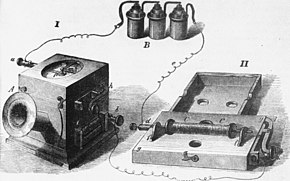This article has multiple issues. Please help improve it or discuss these issues on the talk page. (Learn how and when to remove these messages)
|
The Reis telephone was an invention named after Philipp Reis of a telephone-like device he constructed. Reis's first successful work is dated to October 1861. It was the first device to transmit a voice via electronic signals and for that the first modern telephone. Reis also coined the term.
History
In 1861, Philipp Reis succeeded in creating a device that captured sound, converted it to electrical impulses which were transmitted via electrical wires to another device that transformed these pulses into recognizable sounds similar to the original acoustical source. Reis coined the term telephon to describe his device.
In 1862, Reis demonstrated his telephone to Wilhelm von Legat, Inspector of the Royal Prussian Telegraph Corps who produced an account of it (Legat, 1862), a translation of which was obtained by Thomas Edison in 1875 and which was used in Edison's successful development of the carbon microphone. The Legat account included drawings that are different from that below, suggesting that it is of a later version. Edison acknowledged his debt to Reis thus:
The first inventor of a telephone was Phillip Reis of Germany only musical not articulating. The first person to publicly exhibit a telephone for transmission of articulate speech was A. G. Bell. The first practical commercial telephone for transmission of articulate speech was invented by myself. Telephones used throughout the world are mine and Bell's. Mine is used for transmitting. Bell's is used for receiving.
Microphone
As Reis was considering his invention as a means of broadcasting music, he termed his microphone the 'singing station'. The Reis microphone was based on a horizontal parchment diaphragm as a sound transducer. The diaphragm was mounted on the top of a closed wooden sound box, with a speaking horn on the front. Sound received by the horn caused the diaphragm to vibrate. Above this were two brass strips, later with two platinum contacts, originally with a single platinum contact, and the lower contact formed of a drop of mercury in a recess at the end of the screw. One strip was glued to the center of the diaphragm; another strip, usually two strips in a V, was mounted above this. The strip's weight gave a light pressure between the contacts.
Sound vibrations caused the diaphragm and lower contact to vibrate in sympathy. This changed the resistance between the two contacts, giving an electrical signal to the telephone line.
Patent dispute
There was some question as to the operation of the microphone. It is regarded today as having varied the resistance of the contacts. However, Reis's description claimed that the contacts opened and closed. At the time, it was held that a circuit with such a 'make and break' circuit was incapable of transmitting intelligible speech. Reis's device had been used to transmit speech from 1861, and widely publicly demonstrated from 1863, yet when Bell's patent claim was set against Reis's primacy of inventing the telephone this 'inability' for it to work because of its use of a "false theory" was enough to (legally) portray Reis's invention as invalid, thus allowing Bell to claim novelty.
Loudspeaker

Reis's speaker worked by magnetostriction. In his first receiver he wound a coil of wire around an iron knitting needle and rested the needle against the F hole of a violin. As current passed through the needle, the iron shrank and a click was produced. The image, below, shows an advanced version where the iron bar is clamped to a cigar-box-shaped resonator. This receiver is not very sensitive. It produces weak sound but has good fidelity. It requires very high current and is a current-sensitive device rather than a voltage-sensitive device.
This instrument could transmit continuous musical tones but produced indistinct speech. In 1865, however, British-American scientist David E. Hughes used the Reis telephone with "good results".
See also
- Telephone
- History of the telephone
- Invention of the telephone
- Timeline of the telephone
- List of German inventors and discoverers
References
- Coe, Lewis (2006). The Telephone and Its Several Inventors: A History. McFarland. pp. 16–24. ISBN 9780786426096.
- Turner, Gerard L'Estrange; Weston, Margaret (1983). Nineteenth-century Scientific Instruments. University of California Press. p. 140. ISBN 9780520051607.
- "Ueber Telephonie durch den galvanischen Strom. In: Jahres-Bericht des physikalischen Vereins zu Frankfurt am Main für das Rechnungsjahr 1860-1861, pp. 57-64 by Johann Philipp REIS on Milestones of Science Books".
- Edison, Thomas A. The Edison Papers, Digital Edition Rutgers University, accessed 26 March 2006. LB020312 TAEM 83:170
- 1863 letter to William Ladd, in Thompson (1883)
- ^ "The Reis Transmitter 1862-1872".
- S, E. C. (1 January 1921). "Calendar of Scientific Pioneers". Nature. 106 (2672): 650. Bibcode:1921Natur.106..650E. doi:10.1038/106650a0.
- Legat, V. 1862. "Reproducing Sounds on Extra Galvanic Way". accessed 26 March 2006.
- Friedrich Georg Wieck, Otto Wilhelm Ålund "Uppfinningarnas bok" vol. II, 1874.
- Thompson, Sylvanus P. "Philipp Reis, Inventor of the Telephone" London: E. & F.N. Spon, 1883.
- Coe, Lewis "The Telephone and Its Several Inventors: A History" Chapter 2, McFarland & Co, 1995.
External links
- "The Great Telephone Mystery" accessed September 5, 2006
- BBC - Bell 'did not invent telephone' - Dec 1 2003